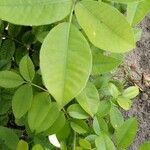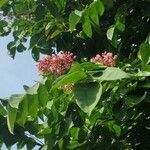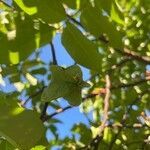Tree, up to 14 m by 30 cm. Branches often drooping. Innovations yellowish to reddish pubescent, glabrescent. Leaves 3-6-jugate, not crowded terminally; rachis up to 20 cm; leaflets up to 10 by 4 cm, variable in shape, lowest not reflexed, acute to acuminate, glaucous beneath; nerves 4-10 pairs. Panicles axillary, rarely ramiflorous, 1-few together, ascending, up to 7 cm long. Flowers heterodistylous (LF, MF), said to be scentless, melliferous. Pedicels 3-6 mm, articulated 1-2 mm below the flower. Sepals up to 4 by 2 mm, bright red, yellowish brown with pale margins when dry, obovate-oblong to triangular, acute to obliquely emarginate, sub glabrous. Petals up to 8 by 2 mm, obovate to lanceolate, coherent, claw c. 1½ mm, glabrous, but inside with minute septate-glandular hairs. Shorter stamens ananthiferous, filaments subulate with often swollen base, up to 1¾ mm, longer ones in LF up to 3 mm, in MF up to 4½ mm. Ovary elliptic, up to 2½ mm long, appressed-puberulous, mainly on the ribs; styles in LF up to 2 mm, in MF ½ mm; ovules 3-5 per cell. Fruit up to 12½ by 6 cm, ovoid to ellipsoid, stellate in ø, lobed at both ends, apically with minute rimae on the ribs. Seeds up to 10, 12 by 5 mm; aril fleshy, bilabiate, enclosing the seed, lobed at base; cotyledons up to 6½ by 3½ mm, elliptic.
A small evergreen tree up to 6-12 m high. The trunk of the tree is short and crooked and has branches near the base. The bark is smooth and dark grey. A leaf is made up of 2 to 11 leaflets with a leaflet at the end. The leaves are darker and more shiny on the top surface. The flowers are small (8 mm long) and red and white in clusters on the small branches. The fruit are star shaped with five or six angled ridges. They are yellow and up to 16 cm long and 9 cm wide. The flesh is white. There are one or two shiny light brown seeds about 1 cm long, in the bottom of each lobe. Some carambola have short styles (female flower parts) and these types need to be cross pollinated by insects. This means two types need planting. Long style types can fertilise themselves. Fruit flavour can vary from very acid to very sweet. There are several named cultivated varieties.
Plants 3-12(-15) m tall, densely branched, young parts finely pubescent or glabrous. Leaves 7-25 cm; petiole 2-8 cm; leaflets (3-)5-13; petiolules 1-2.5 mm; leaflet blades ovate to elliptic, 3-8 × 1.5-4.5 cm, abaxially pubescent to nearly glabrous, base obliquely rounded, apex acute to acuminate. Inflorescences axillary or rameal, panicles or cymes, branches and flower buds crimson. Flowers numerous, small. Sepals narrowly elliptic, 3-5 mm, base sparingly pubescent. Petals white with purple markings or pink to red with darker markings, 6-9 × 3-4 mm. Shorter stamens sterile, occasionally 1 or 2 fertile. Ovary pubescent. Berry yellow to yellow-brown, oblong, 7-13 × 5-8 cm, deeply (3-)5(or 6)-ribbed, stellate in cross section, very fleshy. Seeds numerous, blackish brown. Fl. Apr-Dec, fr. Jul-Dec.
Is occasionally cultivated for its fruits.
Flowers on leafy shoots
Fruit acutely angled
5–10 leaflets









